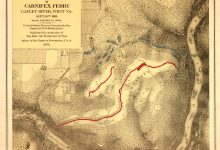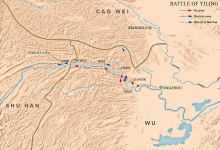The Battle of Ilipa (206 BCE): Turning Point in the Second Punic War
The Battle of Ilipa, fought in 206 BCE, remains a pivotal event in the Second Punic War, marking a significant turning point in the long-standing struggle between the Roman Republic and the Carthaginian Empire. It was a decisive victory for Rome, securing its control over Spain and effectively crippling Carthaginian influence in the region. The battle, though not as well-known as others in the Punic Wars, offers rich insights into military strategy, the shifting dynamics of the war, and the broader geopolitical implications for both empires.
Geographical Context
The Battle of Ilipa took place in the Iberian Peninsula, near the modern-day town of Alcalá del Río, just north of Seville, Spain. The coordinates for the location are approximately 37.517796 latitude and -5.981851 longitude. Situated on the plains of the Guadalquivir River, the area was strategically important for controlling access to southern Spain, a region that had become a critical battleground in the struggle for dominance between Rome and Carthage.
During the Second Punic War, the Iberian Peninsula had proven to be a critical theater of operations. Carthage had established a strong presence in Spain, leveraging its resources and manpower to challenge Rome’s expanding power. The battle at Ilipa thus symbolized not just a local confrontation but a larger struggle for control over the western Mediterranean.
The Forces Involved
The main participants in the battle were the Roman army, led by Publius Cornelius Scipio, and the Carthaginian forces commanded by the general Hasdrubal Barca, the brother of the famous Hannibal Barca. The Roman forces, numbering around 30,000 to 40,000 men, faced a Carthaginian army of roughly the same size. Both armies had significant experience from earlier engagements in the war, but Scipio’s tactical brilliance and strategic foresight proved to be decisive in this encounter.
The Carthaginian army at Ilipa was primarily composed of Iberian mercenaries, Celtic warriors, and North African soldiers. In contrast, the Roman forces were reinforced by well-disciplined legions, supplemented by allied infantry from various parts of the Roman world, including the Celtiberians and Numidians. Despite being evenly matched in terms of numbers, the quality of leadership and battlefield tactics played a crucial role in determining the outcome.
The Battle
The battle unfolded over a series of maneuvers that showcased the skillful use of terrain and the ability to outflank and surprise the enemy. Scipio, known for his flexibility and adaptability, used the difficult terrain around Ilipa to his advantage, positioning his troops in a way that neutralized some of the strengths of the Carthaginian forces.
Initially, Hasdrubal attempted to outmaneuver the Roman legions by using his cavalry, which was considered one of the Carthaginians’ strongest assets. However, Scipio had anticipated this move and deployed his own cavalry strategically to counter this threat. The Numidian cavalry, under the command of the Roman general Masinissa, played a key role in this phase of the battle. Their superior mobility allowed them to harass the Carthaginian flanks and ultimately broke the morale of the Carthaginian cavalry, leaving their infantry exposed.
As the battle wore on, the Romans launched a decisive attack against the Carthaginian infantry, which was spread thin across the battlefield. Scipio’s forces executed a series of coordinated maneuvers, encircling the Carthaginian lines and forcing them into a retreat. The Carthaginians, despite their best efforts, were overwhelmed by the Roman assault and eventually routed from the field.
Aftermath and Consequences
The Battle of Ilipa was a catastrophic defeat for Carthage. Hasdrubal Barca, despite his best efforts, was unable to prevent the collapse of his forces. The defeat resulted in the loss of thousands of Carthaginian soldiers and severely damaged Carthage’s ability to sustain its war effort in Spain. Rome, on the other hand, emerged victorious, solidifying its control over the Iberian Peninsula and effectively cutting off one of Carthage’s key sources of manpower and resources.
In the aftermath of the battle, Scipio’s triumph was pivotal for Rome’s broader strategy in the Second Punic War. The victory at Ilipa laid the groundwork for the eventual Roman conquest of Spain, which would prove essential in the final phases of the war. Scipio’s success also paved the way for his eventual campaign in North Africa, culminating in the decisive Battle of Zama in 202 BCE, where he would face Hannibal Barca and deliver the final blow to Carthaginian power.
Carthage’s loss at Ilipa also had significant political and military ramifications. The defeat weakened the morale of the Carthaginian leadership and led to internal strife within the city-state. The loss of Spain further drained Carthage’s resources, making it difficult for them to sustain their military campaign in Italy and elsewhere.
Historical Significance
The Battle of Ilipa stands as one of the most important battles of the Second Punic War, illustrating the strategic brilliance of Scipio and the decline of Carthaginian fortunes in the western Mediterranean. It also underscores the importance of the Iberian Peninsula in the broader context of the conflict. Had Carthage succeeded in maintaining control over Spain, the balance of power in the Mediterranean could have shifted in its favor, potentially altering the course of history.
Rome’s victory at Ilipa also marked a critical moment in the rise of Roman hegemony in the Mediterranean world. The defeat of Carthage, and the subsequent loss of Spain, weakened the Carthaginian Empire’s ability to challenge Roman expansion. This paved the way for Rome’s eventual dominance in the Mediterranean, which would persist for centuries.
Conclusion
The Battle of Ilipa was not merely a military engagement; it was a defining moment in the Second Punic War that influenced the strategic trajectory of both Rome and Carthage. The outcome of the battle secured Rome’s position in Spain and was a key factor in the eventual Roman victory in the war. Through the leadership of Scipio and the tactical ingenuity displayed at Ilipa, Rome was able to turn the tide of the war and deal a decisive blow to Carthage’s ambitions in the west. This battle, though often overshadowed by the more famous battles of the Punic Wars, was instrumental in shaping the future of the Mediterranean world and the rise of the Roman Empire as the dominant power in the region.
References
- Roy, Kaushik. A Global History of Pre-Modern Warfare. 2021, p.115.
- Scullard, HH. A History of the Roman World. Routledge, p.177, 203, 205.
- Harbottle, TH. Dictionary of Battles. 1995, p.88.





